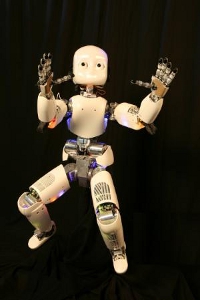Meet the iCub

The iCub is a humanoid robot, developed under the RobotCub project. It is a 53 degree-of-freedom robot, roughly 1m tall, and is equipped with visual, vestibular, auditory, haptic, proprioceptive, and torque sensors.
Each arm has 16 degrees of freedom, with 9 of these located in the hands. The palms and fingertips of each arm contain 108 capacitative tactile sensors on a triangular array. 6-axial force/torque sensors are located in the upper arms.
The legs and torso contain 15 degrees of freedom (3 at the waist), and have 6-axial force/torque sensors located in the thigh.
The head contains 6 degrees of freedom split between the neck and eyes. It contains 2 Dragonfly2 cameras (640*480, 15fps), 2 microphones and pinnae, gyros, digital compass and accelerometers. The head is also capable of displaying facial expressions with mechanised eyelids and LED displays for mouth and eyebrow positions.
Low level control is provided on board by a PC104 card with dual Intel Core 2 Duo 2.16MHz processors. Data transfer to/from the robot is via a Gbit/s Ethernet port.
The iCub is currently involved with the research project MoDeL.
Previous Research/Projects on iCub:
 The iCub was successfully used within the IM-CLeVeR project to investigate developmental learning processes.
The iCub was successfully used within the IM-CLeVeR project to investigate developmental learning processes.
Development in the human infant is restricted by a series of constraints, which restrain the infant's action repertoire and sensing capabilities. Initially, these constraints reduce the perceived complexity of the environment and limit interaction, providing a scaffold that helps the infant to make sense of the world. As the infant learns, these constraints are then gradually eased or lifted, allowing the infant to advance into a new stage of development.
The research investigated these ideas of staged development and led to an efficient robotic learning architecture in which sensorimotor competence grows cumulatively.
Videos of the iCub in action can be seen from the following pages:
